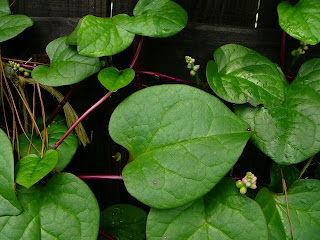Also hidden was this cucumber:
 Camouflaged amidst all the leaves as well (and all the way in the back of the trellis. Easily a one pound cucumber! Pickles... or cucumber salad...? Cucumber salad for lunch today!
Camouflaged amidst all the leaves as well (and all the way in the back of the trellis. Easily a one pound cucumber! Pickles... or cucumber salad...? Cucumber salad for lunch today!(another quick update: I was able to get the asparagus that popped up randomly in time and was it sweet and delicious. Hurray for fresh asparagus in July! Literally 2 minutes from garden to my plate)
Anyways, on to my story:
As I was walking out of the place I volunteer at earlier this week, I walked to my car, hopped in, and stared out the window in slight disbelief. Approximately 6 feet away, hanging by vines in a little past the cut grass of the parking lot into the wooded area were these green egg shaped things swinging in the wind.
Wild/native kiwi? I first thought initially, except I was pretty sure kiwi weren't native. I couldn't remember what kiwi leaves looked like and then I saw this flower (bad pic, sorry):

I started nearly jumping for joy when I realized that I had discovered a native maypop, aka passionflower vine growing on the property!!! I nearly ripped the entire vine from the ground until I thought better and grabbed a flower and fruit first so that I could show the administrative staff at my volunteering place.
They were nonplussed, and sort of thought, "Wha---?" and when I asked them if I could dig up the passionflower vine they said it was ok as long as I didn't get eaten by coyotes in the woods.
Easy enough.
Being too impatient to drive the 10-15 minutes home to grab the proper tools, I decided to give the vine a yank at the bottom since it had been raining and the ground was soft. Hmm... I got some (broke off) tap root and bent up the vine a little near the base in the process. That might not be good for the vine and so I found another vine and attempted to pull that up and same thing, some tap root, but no full rootiness.
Well, just to try to have more chances of success as these becoming established I took both vines, each over 6 feet in length, with fruit and flowers on them (not smart to take the entire thing probably, lots of plant to sustain with a lot less root now) and wrapped them into my car.
I popped them straight into a bucket of water and the weather has been cool out so I am hoping that I may see some roots developing that I might find a nice place to let the maypop carry on with regular growing activity and give me delicious fruit. If not this year, maybe the next!
(UPDATE: 3 days in and there be new roots growing! Also, I'd like to note that I have been trying to grow maypops prior to this discovery, receiving little seedlings from a local gardener lady, but the damn things always get eaten by squirrels/placed in poor areas by me/I break them >_<)
Passionflowers are a fascinating looking flower with a lot of symbolism/backstory to the Passion of Christ. The parts supposedly signify:
- The pointed tips of the leaves were taken to represent the Holy Lance.
- The tendrils represent the whips used in the Flagellation of Christ.
- The ten petals and sepals represent the ten faithful apostles (less St. Peter the denier and Judas Iscariot the betrayer).
- The flower's radial filaments, which can number more than a hundred and vary from flower to flower, represent the Crown of Thorns.
- The chalice-shaped ovary with its receptacle represents a hammer or the Holy Grail
- The 3 stigmata represent the 3 nails and the 5 anthers below them the 5 wounds (four by the nails and one by the lance).
- The blue and white colors of many species' flowers represent Heaven and Purity.
Pretty cool eh?
Passionflowers are commonly called Maypops in the southeastern part of the U.S where they are native because in May they seemingly pop out of nowhere. I have also heard from locals that they are named this because the fruits are ripe sometimes trailing on the ground, when stepped upon they "may pop." Ah, local lore.
They are a deciduous vine as compared to its South American tropical companion vine you might find in grocery stores. The tropical ones in grocery stores have an orange flesh with little black seeds and purple-black skin when ripe. Maypop fruit however have greyish-white flesh with black seeds and orange skin when ripe. This orange skin gives it is other name, apricot vine.
Interestingly enough, the parts of the plant, leaves, stem, flowers, when eaten together apparently produce a combination of chemicals, that can help with sleep and are anxiety reducer. Use of passionflower as a medicinal is unusual in the States, but popular in Europe.
Though the fruits of the maypop I have now are green and still unripe, I took one and cut it open curious to see what it looked like. Pretty drab white spongy flesh. When it ripens up I've seen pictures where the entire fruit case is filled with big cells of the fruit, like a pomegranate's, with the black seeds within each cell.
Taking pictures of the unripe fruit though was still a lovely experience as the light of my camera would allow the green skin to show through from the inside.
Enjoy!








































